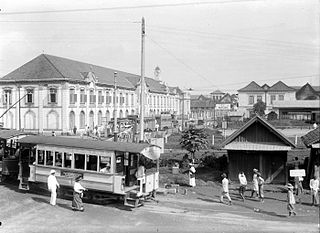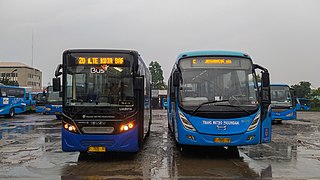
Bekasi is a city in West Java, Indonesia, located on the eastern border of Jakarta. It serves as a commuter city within the Jakarta metropolitan area. According to the 2020 Census by Statistics Indonesia (BPS), Bekasi had 2,543,676 inhabitants. The official estimate for mid 2023 was 2,627,207 - comprising 1,320,682 males and 1,306,525 females. It lies within the largest metropolitan area in Indonesia (Jabodetabek). The city is bordered by Bekasi Regency to the north and the east, Bogor Regency and Depok City to the south, and the city of East Jakarta to the west.

Transjakarta or Jakarta BRT is a bus rapid transit (BRT) system in Jakarta, Indonesia. The first BRT system in Southeast Asia, it commenced operations on 15 January 2004 to provide a fast public transport system to help reduce rush hour traffic. The system is considered as the first revolutionary public transit mode in the capital city of Indonesia. The buses run in dedicated lanes (busways), and ticket prices are subsidised by the regional government. Transjakarta has the world's longest BRT system, which operates about 4,300 buses. Transjakarta aims to have 50 percent of its fleet be electric buses by 2027. By 2030, the aim is for the entire Transjakarta ecosystem to use electric buses. As of November 2023, it serves an average of 1.134 million passengers daily.
PT Industri Kereta Api (Persero), abbreviated as INKA, is an Indonesian state owned rolling stock manufacturer.

Pulo Gebang Bus Terminal is a type-A bus terminal at Cakung, in East Jakarta, Indonesia, which is arguably the largest of its kind in Southeast Asia. The terminal was opened on 28 December 2016. Designed by Paul Tanjung Tan, this terminal is built to replace the unfeasible Pulo Gadung terminal and providing a comfortable, safe, and well-accessible transportation service. Buses to and from Central & East Java usually use this terminal.

Jalan Jenderal Gatot Subroto(Gatot Subroto Avenue) is one of the major roads in Jakarta, Indonesia. The road starts from Dirgantara statue in South Jakarta, which crosses 10 administrative villages and ends at Slipi, Central Jakarta. The road is named after National Hero of Indonesia General Gatot Subroto. The road was constructed in 1960s. The road runs parallel with Jakarta Inner Ring Road. The location of the road is within the Golden Triangle CBD of Jakarta. Many important office buildings and skyscrapers are situated along the road.

DAMRI Public Corporation is an Indonesian state-owned bus operator. Under further development as a public company, the name DAMRI is still used as a brand mark of this state-owned company that still carries out passenger and cargo transport using buses and trucks.
In Indonesia, state-owned enterprises play an important role in the national economy. Their roles includes contributor for national economy growth, providing goods or services which are not covered by private company, employment provider, providing support guidance to small and medium businesses, and source of government revenue. The Ministry of State Owned Enterprises represents the government's function as a shareholder of most of those companies, while some are represented by the Ministry of Finance.

The Jakarta tram system was a transport system in Jakarta, Indonesia. Its first-generation tram network first operated as a horse tram system, and was eventually converted to electric trams in the early twentieth century.

The TransJakarta Corridor 1 is the TransJakarta bus rapid transit route in Jakarta, Indonesia. The route operates between Blok M Terminal and Jakarta Kota railway station. It is the first route of the TransJakarta BRT system. The roads that are traversed by corridor 1 are along Jalan Sultan Hasanuddin, Trunojoyo, Sisingamangaraja, Sudirman, MH Thamrin, Medan Merdeka Barat, Gajah Mada / Hayam Wuruk, Pintu Besar Utara, Kali Besar Barat, Kunir, and Lada Dalam. Key integration points include Dukuh Atas TOD that is currently an integration point for four transport modes, Jakarta Kota Station which serves KRL Commuterline, and Harmoni Central BRT station that is one of the main hubs in the BRT system. Currently, all bus stations are served by buses 24 hours a day.

Metrotrans is a bus operated by TransJakarta. Introduced in 2017, replacing aging MetroMini and Kopaja buses, The Metrotrans bus design is based on European-styled low floor bus. A newer, electric powered bus joined the line up since 2022. Those electric buses are from Chinese companies such as BYD, Skywell, Golden Dragon, and Zhongtong.

Trans Semarang is a bus transit system in Semarang City and (partly) Semarang Regency, Central Java, Indonesia. The service is aim to break down congestion in Semarang and to accommodate commuters to the city center and tourist destinations in the city. One that distinguishes Trans Semarang from other city bus services is its high-deck fleet so that service users use special shelters.

Transjakarta Corridor 9 is a bus rapid transit corridor in Jakarta, Indonesia, operated by Transjakarta. The corridor connects the Pinang Ranti bus terminal in East Jakarta with the Pluit BRT station in North Jakarta. The roads traversed by corridor 9 are: Jalan Pondok Gede Raya, Jagorawi Toll Road, Jalan Mayjen Sutoyo, Jalan Letjen M.T. Haryono, Jalan Jend. Gatot Subroto, Jalan Letjen S. Parman, Jalan Satria/Prof. Dr. Makaliwe, Jalan Prof. Dr. Latumeten, Jalan Jembatan Tiga, and Jalan Pluit Putri/Putra. Corridor 9 is integrated with the KAI Commuter Bogor Line service at the Cikoko BRT station that connects to the Cawang railway station and the Tangerang Line at Kali Grogol BRT station that connects to the Grogol railway station. Corridor 9 is also integrated with Jabodebek LRT from Cawang to Pancoran BRT stations.

TransJakarta Corridor 10 is a bus rapid transit corridor in Jakarta, Indonesia, operated by TransJakarta. It connects the Tanjung Priok bus terminal in North Jakarta to the Pusat Grosir Cililitan (PGC) mall in East Jakarta. The streets traversed by corridor 10 are along Enggano street and the Djakarta Bypass. Corridor 10 is integrated with the KRL Commuterline Cikarang Loop Line service at Jatinegara Station via Flyover Jatinegara BRT station and the Tanjung Priok Line at the Tanjung Priuk railway station.

The TransJakarta Corridor 7 is a bus rapid transit corridor in East Jakarta, Jakarta, Indonesia, operated by TransJakarta. It connects the Kampung Rambutan Bus Terminal in Ciracas to the Kampung Melayu Bus Terminal in Jatinegara. The streets that passed by corridor 7 are Gedong Timur/Barat, Raya Bogor, Mayjen Sutoyo, MT Haryono, and Otto Iskandardinata streets. This corridor is the only TransJakarta corridor that is not integrated with the KRL Commuterline system, because the distance between the Kampung Melayu station and the nearest Commuterline station, Tebet, is quite far.

Blok M Terminal is a type-B bus terminal located within the commercial and entertainment quarter of Blok M in Kebayoran Baru, Jakarta, Indonesia. It only serves city transport buses that connects several regions in Jakarta and its surrounding cities. The terminal primarily serves Transjakarta's BRT corridors and feeder routes. Perum DAMRI also operates numbers of shuttle bus services from the Soekarno–Hatta International Airport and several gated communities in Greater Jakarta to Blok M terminal. Apart from DAMRI, Mayasari Bakti and Sinar Jaya also operates their bus routes to this terminal.

TransJakarta Corridor 12 is a bus rapid transit corridor in Jakarta, Indonesia, operated by TransJakarta. It connects the Pluit BRT station to the Tanjung Priok bus terminal. The streets that passed by corridor 12 are along Pluit Putri/Putra, Pluit Timur, Pluit Selatan, Jembatan Tiga, Bandengan Selatan, Gedong Panjang, Kopi, Tiang Bendera 5, Roa Malaka Utara, Tiang Bendera, Kunir, Lada Dalam, Bank, Kali Besar Barat, Jembatan Batu, Mangga Dua, Gunung Sahari, Angkasa, HBR Motik, Danau Sunter Barat, Danau Sunter Utara, Mitra Sunter Boulevard, Danau Sunter Selatan Dalam, Yos Sudarso, and Enggano streets. This corridor is integrated with Jakarta Kota Station at the Kota BRT station, Kampung Bandan Station at Mangga Dua BRT station, and also the Tanjung Priuk railway station at the Tanjung Priok terminal.

The TransJakarta Corridor 3 is a bus rapid transit route in Jakarta, Indonesia, operated by TransJakarta. It serves from the Kalideres Bus Terminal to the Monumen Nasional Bus Station. The streets that passed by corridor 3 are: Daan Mogot, Kyai Tapa, Hasyim Ashari, Cideng Barat/Timur Street, Veteran/Majapahit, and Medan Merdeka Barat. Corridor 3 is integrated with KAI Commuter Tangerang Line at Taman Kota Station and Pesing Station.

Trans Metro Pasundan, simplify TMP is a transit bus system in the Bandung metropolitan area, West Java, Indonesia. This service is part of the Teman Bus Buy-the-Service (BTS) purchasing program initiated by the Directorate General of Land Transportation of the Ministry of Transportation. The system began operation on 21 December 2021, with its inauguration six days later. TMP is operated by the state-owned Perum DAMRI and Big Bird, a subsidiary of Blue Bird Group.


























